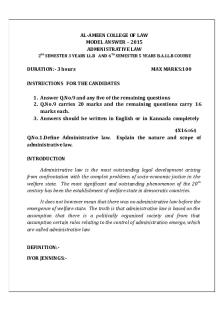Poiseuille law - Lecture notes 1 PDF

| Title | Poiseuille law - Lecture notes 1 |
|---|---|
| Course | Applied Anatomy & Physiology 1 |
| Institution | University of Portsmouth |
| Pages | 1 |
| File Size | 51.1 KB |
| File Type | |
| Total Downloads | 73 |
| Total Views | 150 |
Summary
Description of Poiesuille's Law and the physiology of systemic circulation...
Description
Poiseuille’s Law Flow decreases when resistance increases and vice versa. Since resistance is proportional to blood vessel diameter, constriction of a blood vessel increases resistance and thus decreases flow. Flow =(P1 –P2)/R or (P1 –P2)r4/8vl r = radius of vessel, v = viscosity, l = length of vessel
-
Rate of blood flow is directly proportional to the forth power of the radius of the vessel, which demonstrates that the diameter of a blood vessel plays the greatest role of all factors in determining the rate of blood flow through a vessel.
During exercise, the heart beats with greater force increasing pressure in the aorta. Capillaries in skeletal muscle increase in diameter decreasing resistance and increasing flow. Increased flow in the aorta can go from 5L/min to 25L/min.
Physiology of Systemic Circulation •
•
Determined by –
Anatomy of circulatory system
–
Dynamics of blood flow
–
Regulatory mechanisms that control heart and blood vessels
Blood volume –
Most in the veins (greater compliance)
–
Smaller volumes in arteries and capillaries...
Similar Free PDFs

Poiseuille law - Lecture notes 1
- 1 Pages

LAW - Lecture notes 1-15
- 13 Pages

Natural Law - Lecture notes 1
- 4 Pages

Natural Law - Lecture notes 1
- 8 Pages

Constitutional Law - Lecture notes 1
- 22 Pages

Hindu Law - Lecture notes 1
- 18 Pages

Reviewer law - Lecture notes 1
- 4 Pages

Constitutional Law - Lecture notes 1
- 108 Pages

Common Law - Lecture notes 1
- 2 Pages

Civil LAW - Lecture notes 1
- 14 Pages

Administrative Law - Lecture notes 1
- 48 Pages

Hindu Law - Lecture notes 1
- 117 Pages

Medical Law 1: Lecture Notes
- 36 Pages

Law Reviewer - Lecture notes 1
- 9 Pages

Consti LAW 1 Reviewer - Lecture notes 1
- 227 Pages
Popular Institutions
- Tinajero National High School - Annex
- Politeknik Caltex Riau
- Yokohama City University
- SGT University
- University of Al-Qadisiyah
- Divine Word College of Vigan
- Techniek College Rotterdam
- Universidade de Santiago
- Universiti Teknologi MARA Cawangan Johor Kampus Pasir Gudang
- Poltekkes Kemenkes Yogyakarta
- Baguio City National High School
- Colegio san marcos
- preparatoria uno
- Centro de Bachillerato Tecnológico Industrial y de Servicios No. 107
- Dalian Maritime University
- Quang Trung Secondary School
- Colegio Tecnológico en Informática
- Corporación Regional de Educación Superior
- Grupo CEDVA
- Dar Al Uloom University
- Centro de Estudios Preuniversitarios de la Universidad Nacional de Ingeniería
- 上智大学
- Aakash International School, Nuna Majara
- San Felipe Neri Catholic School
- Kang Chiao International School - New Taipei City
- Misamis Occidental National High School
- Institución Educativa Escuela Normal Juan Ladrilleros
- Kolehiyo ng Pantukan
- Batanes State College
- Instituto Continental
- Sekolah Menengah Kejuruan Kesehatan Kaltara (Tarakan)
- Colegio de La Inmaculada Concepcion - Cebu
